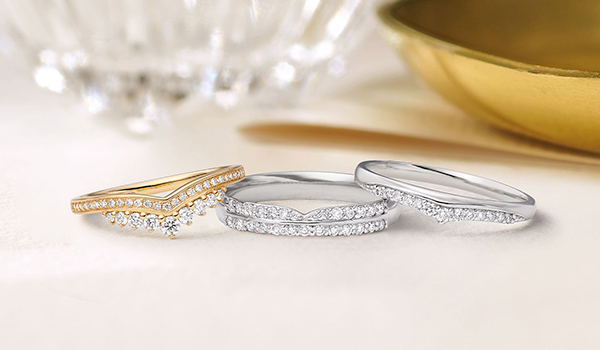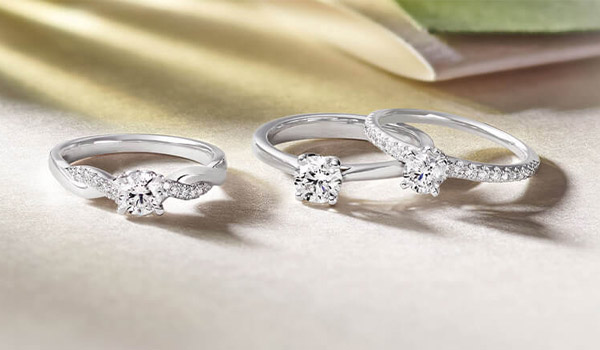-
Bead Setting
A bead setting is used for small diamonds. They are held onto the surface by small beads of metal raised from the ring itself – otherwise known as a pavé setting. Find out more about each diamond setting here.
-
Bezel Setting
Also known as rub-over settings, the metal completely surrounds the outer edge of the stone offering a very secure setting and the illusion of a larger diamond. Find out more about each diamond setting here.
-
Brilliant Cut
This is one of the three major diamond cutting techniques and the most popular. It features 57 for 58 facets that radiate from the diamonds centre towards its girdle, giving a diamond an optimal brilliance and light reflection.
-
Care Card
This gives you the confidence your diamond will be looked after forever. We offer a care card with every diamond purchase, giving you a lifetime of free diamond cleaning, care and advice at any of our stores.
-
Channel Settings
Popular for ring shoulders and also for eternity and wedding rings, this setting allows for a continuous flow of multiple diamonds within a channel, creating a uniform sparkle. Find out more about each diamond setting here.
-
Claw Settings
The shape of the stone can determine the number of claws required to hold a diamond, for example a teardrop stone may require three claws whereas as a round brilliant stone will need four. The tips of the claws can be shaped if desired. This type of setting can let a lot of light through the stone. Find out more about each diamond setting here.
-
Conflict Diamonds
Otherwise known as ‘blood diamonds’, conflict diamonds are mined in a war zone and used to highlight the negative consequences of the diamond trade in Africa. Every Beaverbrooks diamond has a written assurance to prove they’re from legitimate sources not involved in funding conflict and are in compliance with United Nations resolutions. See more under the Kimberley Process.
-
Culet
Refers to very small facet on the bottom of the pavilion on a diamond, parallel to the table. It is also spelled collet and culette.
-
Depth
The depth of a diamond is measured from the culet at the bottom, to the table facet at the top.
-
Facet
Facets are the flat, polished surfaces on a diamond.
-
Fire
Refers to the flashing colours seen when a suitably cut diamond is moved, resulting from its dispersion. Fire, brilliance and scintillation all work together to create the sparkle, and they’re all most affected by the quality of the cut.
-
GIA Diamond
These are diamonds certified by the Gemmological Institute of America, the best diamond grading laboratory in the world. Not all diamonds are certified by GIA, however we do have our own range of Beaverbrooks GIA certified diamonds that you can find here.
-
Grader
This is the skilled person who separates polished diamonds into sizes and quality grades by clarity, colour, and accuracy of cut.
-
Hammer Setting
Otherwise known as a gypsy setting, the stone is set into the metal of the ring itself and is flush with the surface. The stones are well protected as they do not rise above the surface of the ring. Find out more about each diamond setting here.
-
Kimberley Process
The Kimberley Process Certification Scheme (KPCS) is the process established in 2009 to prevent "conflict diamonds" from entering the mainstream rough diamond mark by United Nations General Assembly Resolution 55/56 following recommendations in the Fowler Report. The process was set up "to ensure that diamond purchases were not financing violence by rebel movements and their allies seeking to undermine legitimate governments."
-
Loupe
This is a small magnifying glass used by jewellers to measure and inspect diamonds and their settings.
-
Mixed Cut
One of the three major diamond cutting techniques, the mixed cut combines step cut and brilliant cut facets, with brilliant facets on the crown and step facets on the pavilion, or vice versa. You’ll most likely see this cutting pattern used a cushion or oval shaped diamond.
-
Pavé Setting
A setting used for small diamonds; they are held onto the surface by small beads of metal raised from the ring itself – otherwise known as a bead setting. Find out more about each diamond setting here.
-
Rough Diamond
A rough diamond refers to a diamond that has just been mined in its natural state. They’re then cut and polished to create the diamonds we know in our beautiful jewellery.
-
Setting
This is the way the diamond is fixed into place. There are many different settings such as claw, channel, pavé, gypsy and tension, each on give the diamond a unique overall style. Find out more about each diamond setting here.
-
Star
The star facets are found around the table. They let a multitude of light through and shine in different directions to create more brilliance.
-
Table
This is the large facet in the centre and on the top of the diamond. The table plays a vital role in sparkle and can vary in size depending on the diamond’s cut.
-
Upper Girdle
These are diamond facets that sit above the girdle, leading on to the bezel facets. They help to reflect fire and brilliance.
-
Bezel
Bezel facets sit next to the star facets around the diamond table. A round brilliant diamond has eight bezel facets that are ‘kite’ shaped and help to form the crown.
-
Brilliance
Brilliance is what makes a diamond sparkle. A correctly cut diamond increases the reflection of the light and has a magnificent brilliance. Fire, brilliance, and scintillation all work together to create the sparkle, and they’re all most affected by the quality of the cut.
-
Carat
A carat is often confused as the size of a diamond, when in fact it is actually the measure of a diamond’s weight. Put simply, the more a diamond weighs, the rarer the diamond is.
-
Certificate
This certifies the quality of a diamond based on its 4 Cs. For us, a standard grading report is never enough. At Beaverbrooks we only work with expert diamond suppliers who excel in the artistry and science of cutting exceptional diamonds, and for this reason we only ever offer our own Diamond Certificate graded by our experts.
-
Clarity
A diamond is given a grade to describe the level of inclusions or imperfections. The less imperfections, the better the clarity. All diamonds have inclusions. It’s what makes them unique like a fingerprint.
-
Colour
This describes the colour tones in a diamond. A diamond should be as colourless as possible. Diamonds range in colour from D to Z. At Beaverbrooks, we only hand select exceptional ‘rare white’ diamonds for our platinum and 18 carat gold ranges (G grade).
-
Crown
This is the upper part of a diamond between the girdle and the table, made up of star facets, bezel facets and the upper girdle.
-
Cut
The cut refers to the reflective qualities of the diamond. Behind every quality diamond is a skilled cutter. We take great pride in scrutinising the cut of each diamond we hand select, as only diamonds expertly cut perform with true fire, brilliance, and scintillation.
-
Dispersion
Dispersion describes the way a diamond breaks up a ray of white light into colour.
-
Fancy
A fancy diamond is a diamond of an attractive colour other than white that is suitable for gem use.
-
Fluorescence
Around 30% of diamonds will have a fluorescence effect which is the glow a diamond emits under ultra-violet (UV) light, often seen as blue. This is graded by GIA the same way diamond colours are. A diamond with a lower colour grade but high fluorescence grade may appear whiter as it helps to cancel out the yellow tint.
-
Girdle
The girdle is the thin perimeter that divides the crown from the pavilion. Round brilliant diamonds have faceted girdles to give greater transparency of the diamond.
-
Gypsy Setting
Otherwise known as a hammer setting, the stone is set into the metal of the ring itself and is flush with the surface. The stones are well protected as they do not rise above the surface of the ring. Find out more about each diamond setting here.
-
Inclusion
Inclusions are internal imperfections in a diamond, such as a spot or irregularity. Irregularities are usually small fractures. In higher quality stones the inclusions are only visible under magnification. The fewer the inclusions, the better the clarity grade.
-
Laboratory Grown Diamonds
Gemmologists consider lab grown diamonds to be genuine diamonds because they have the exact same physical and chemical composition as mined diamonds. The difference between lab-grown diamonds and real diamonds is their origin and time taken to grow; real, earth-grown diamonds take millions of years to form under the earth’s crust, whilst lab-grown diamonds are formed in up to ten weeks. At Beaverbrooks, we believe natural diamonds are one of the most precious gemstones, that symbolise love and eternity, and that nothing compares to the rarity of a natural diamond.
-
Lower Girdle
Lower girdle facets sit just below the girdle and next to the pavilion. They help to reflect light into a multitude of directions.
-
Mohs Scale
This is a scale of mineral hardness from 1 to 10, characterizing scratch resistance of minerals through the ability of harder material to scratch softer material. Diamonds are rated the highest at 10, meaning they’re classed as the hardest mineral ever.
-
Pavilion
The pavilion is the bottom half of a diamond. The facets within the pavilion help light bounce, enter and reflect through a diamond.
-
Scintillation
Scintillation is the amount of light that is reflected from the diamond as it moves. It’s the combination of fire and brilliance. Fire, brilliance and scintillation all work together to create the sparkle, and they’re all most affected by the quality of the cut.
-
Shape
A diamond shape describes the geometric appearance of a diamond. From oval to pear, find out more about the different diamond shapes here.
-
Step Cut
One of the three major diamond cutting techniques, a step cut showcases long and narrow four-sided facets in rows parallel to the girdle on both sides of the crown and pavilion. This faceting style is great for emphasising a diamond’s colour and clarity. The most common step cut is the emerald cut.
-
Tension Setting
Tension settings – this setting relies on the pressure of the metal to hold the stone in place, making it seem as if the stone is floating. Very modern and eye-catching, it will allow the maximum amount of light to pass through the stone. Find out more about each diamond setting here.
Meet our experts
One of our diamond experts, Lorna, talks you through how to choose the perfect diamond.

“We hand select our diamonds and choose
settings that complement them the best, paying attention to the details that matter the most.
Whether it’s an engagement ring on your finger or a tennis bracelet on your wrist, our diamonds
don’t just sparkle, they feel amazing too.”
– Lorna, Head of Diamond Buying.
Diamond FAQs
Our experts answer some of your most frequently asked questions on diamonds.
-
Are diamonds a good investment?
Not only are diamonds the most sought-after gemstones, but their meaning also makes them a gift to last a lifetime. The perfect family heirloom, if looked after correctly your diamond can be passed down for years to come making them a true investment jewellery piece.
-
Do diamonds hold their value?
There is a finite supply of natural diamonds which means your diamond will hold its value. Our Diamond Care Card will ensure your diamond has the best possible aftercare for its lifetime which will also help in holding its value overtime.
-
How to buy diamonds?
If you don’t know where to start when it comes to buying a diamond, we’re here with you every step of the way.
If you’re buying online, our Diamond Buying Guide is the perfect place to start your research, whilst our Customer Service Team are available through our live chat to talk you through the purchase stage.
If you’re buying in-store, our expert advisors are ready to find “the one”, simply find your nearest store or book an appointment today.



